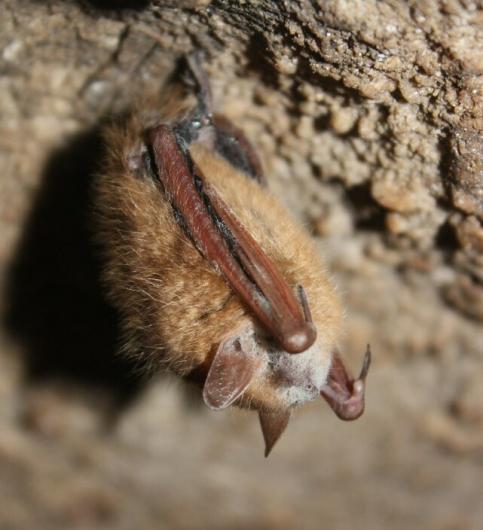White Nose Syndrome in New Mexico
White-nose syndrome (WNS) is a disease that affects hibernating bats and is caused by the fungus, Pseudogymnoascus destructans (Pd). WNS has killed millions of bats and had a significant impact on bat populations across the eastern and mid-western United States.
In 2021 Pd was detected on hibernating bats and cave walls in two eastern New Mexico caves managed by the Roswell Field Office. Bats with white-nose syndrome were confirmed in the same two caves in 2023.
More than half of the 29 bat species that occur in New Mexico hibernate in the winter and therefore may be susceptible to WNS. It is unknown to what extent WNS will impact New Mexico’s bat populations, therefore bats and caves will continue to be monitored for the presence of WNS and Pd.
Because WNS can potentially be carried between infected caves and non-infected caves on cavers shoes, gear, and clothing, BLM has limited access to research only for the 23 caves in New Mexico that have hibernacula on BLM administered public lands.
BLM is managing these 23 caves with significant bat hibernacula through the issuance of Special Recreation Permits for research only, under the guidance of the 2014 Interim Management Policies and Procedure IM:
- Caves administered by the Carlsbad Field Office:
- Billy the Kid, Endless, McKittrick, Rusty Hinge, Adobe, and Yellow Jacket Caves
- Caves administered by Las Cruces District Office:
- U-Bar, and Lepto Splat Caves
- Caves administered by the Rio Puerco Field Office:
- Whut
- Caves administered by the Roswell Field Office:
- Bat Hole, Big-eared, Corn Sinkhole, Crockett's, Crystal, Feather, Fly, Fort Stanton, Malpais Madness, Smiley, Sun Spot, Torgac's, Torgac's Annex, Tres Niños Caves, and Martin-Antelope Gyp Cave Complex
- Caves administered by the Socorro Field Office:
- Ladrone Cave
BLM-New Mexico has documented about 500 caves on public land that meet the significance criteria under the Federal Cave Resource Protection Act of 1988 (Act). We estimate at least as many have not yet been inventoried. The Interested public can contact their local BLM office for information about caves open for exploration. The BLM does not distribute cave locations per the Act.
- What is White-Nose Syndrome?
-
White-nose Syndrome (WNS) is a fungal disease that has killed more than five million hibernating bats across the northeast and mid-Atlantic United States and Canada during the past seven years and continues unchecked. Bats with WNS may exhibit a white fungus that is found around the muzzle, ears, and especially the wings of affected individuals.
The agent of WNS is a newly described fungus Psuedogymnoascus destructans (Pd), which causes an invasive skin infection that is the primary characteristic of this disease. As of June 2014, WNS has spread to 25 states and 5 Canadian provinces. Mortality of this magnitude from an infectious disease is not only unprecedented among bats worldwide, but also among wild mammals.
- What causes the bats to die?
-
We don’t entirely understand how the fungus kills bats. One possibility is that fungal infection disturbs bats while hibernating which leads to more frequent or longer awakenings and accelerates the use of fat reserves. However, fat depletion is not consistently observed among all bats with WNS. Another option is that some infected bats shift from areas in caves or abandoned mines with stable temperatures to entrances with more variable temperatures. Sometimes bats depart early from hibernacula, exposing themselves to cold which could account for some mortality. However, greater focus is currently on the fungal damage that WNS inflicts on wing membranes. Wings play a key role in maintaining water balance, temperature, blood circulation, and skin respiration so disrupting any of those key functions would increase mortality.
- How is White-Nose Syndrome Spread?
-
Bat-to-bat: Bat-to-bat transmission of Pd has been documented in lab conditions and is believed to be the primary route of transmission of fungal spores.
Infected environment-to-bat: Recent research indicates that viable fungus persists in bat guano, and on the floors and walls of contaminated sites. The fungus remains viable in cave sediments “for a long time,” and can even persist in the absence of bats.
Cave/Abandoned Mine-to-Humans-to-Bats: Aspects of the geographic spread suggest that humans can transmit WNS from infected sites to clean sites. Both the U.S. Geological Survey and the New York State Department of Environmental Conservation have isolated fungal spores on equipment and clothing after exiting a contaminated cave. This kind of spread is most likely occurring from clothing and equipment that are not properly cleaned and decontaminated between sites. Formal testing of human-spread WNS is ongoing. Because of the devastating effects of WNS, it is critical that people assume responsibility for the potential spread of WNS.
- Does White-Nose Syndrome pose a risk to human health?
-
WNS is in caves and mines that have been visited by hundreds of people during the past six years, yet there have been no reported human illnesses attributable to it. However, because scientists are still learning about WNS, we do not know if there is a risk to humans from contact with affected bats, and we cannot advise you about human health risks.
- How can I help?
-
- Avoid entering caves and mines to protect resident bats.
- If a cave or mine must be entered, clothing and gear must be decontaminated following current guidelines (white-nosesyndrome.com).
- Do not handle animals that appear sick or are found dead.
- Advise the local BLM Field Office, the U.S. Fish and Wildlife Service, or the New Mexico Department of Game and Fish if you have seen bats that may have this disease, or if you see bats behaving strangely during daylight hours.

